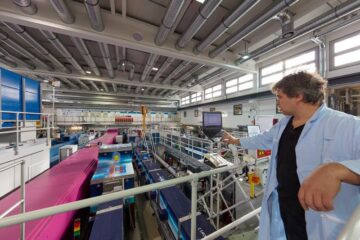Why are there so few women in industrial research?

Whilst women make up more than 50 % of all graduates in higher education in the European Union, they represent only 15 % of researchers in industry. Fundamental changes in research culture, recruitment and careers are needed across industrial research.
On 23 January 2003 in Brussels, European Research Commissioner Philippe Busquin will present a report, prepared by a EU-sponsored group of experts who analysed the situation of women in industrial research and presented conclusions and recommendations. The aim is to improve the situation by 2010. The report calls for action by the private sector and highlights the need for governments, universities and other stakeholders to act.
Women account for almost one third of researchers in universities and public research institutions, but only for 15% in industry (1999 figures). Although more than one third of all European industrial researchers are based in Germany and Austria, the proportion of women is as low as 9.6% and 9% respectively. In other Member States, the proportion of women ranges from 17.8% (Finland) to 28.2% (Ireland).
The Expert group that will publish the report is chaired by Professor Helga Rübsamen-Waigmann, Vice President of Bayer AG, Head of Antiinfective Research, and Dr. Ragnhild Sohlberg, Vice President of Norsk Hydro ASA, Corporate Center. Around 50 top-level experts from leading research and development (R&D) companies and innovative small and medium-sized enterprises (SMEs), as well as senior researchers, contributed to this work.
The Report will be presented at a conference, open to the press, on 23 January at 11:30 at the European Commission’s Charlemagne building, rue de la Loi 170, room S2, B-1000 Brussels. A press conference will be held at 12:30 at the same location (see enclosed programme).
Conference: A Vision for Europe – Women in Industrial Research.
A wake up call for European Industry
Brussels, 23 January 2003, 11:30 – 13:00 h,
Charlemagne building, rue de la Loi 170, Room S2
B-1000 Brussels
11.30: Presentation of the Report on Research and Development (R&D) in European Industry – How can we reach our goal if we ignore women, who represent half our talent pool? (open to the press)
* Introduction of European Research Commissioner Philippe Busquin
* Prof. Dr. Helga Rübsamen-Waigmann, chair of the expert group, Vice
President of Bayer AG, Head of Antiinfective Research
* Dr. Ragnhild Sohlberg, vice-chair and chair of the subgroup on best
practices, Vice- President, Norsk Hydro ASA
* Dr Theresa Rees, University of Cardiff, Professor at the School of
Social Sciences
* Pierre Bismuth, chair of the subgroup on young scientists,
Vice-President Personnel, Schlumberger Ltd.
* Conclusions of Commissioner Busquin.
12.30: Press conference with Commissioner Busquin
Followed by a buffet lunch until 14:00
Fabio Fabbi
EU Commission
Spokesman for Research & Development – Commissioner Philippe Busquin
Office: Breydel I, 6/126
B-1049 Brussels
Fon +32 2 296.41.74
GSM +32 (0)498 96.41.74
Fax +32 2 296.30.03
e-mail: Fabio.Fabbi@cec.eu.int
Media Contact
Weitere Informationen:
http://europa.eu.int/comm/press_roomAlle Nachrichten aus der Kategorie: Veranstaltungsnachrichten
Neueste Beiträge

Bakterien für klimaneutrale Chemikalien der Zukunft
Forschende an der ETH Zürich haben Bakterien im Labor so herangezüchtet, dass sie Methanol effizient verwerten können. Jetzt lässt sich der Stoffwechsel dieser Bakterien anzapfen, um wertvolle Produkte herzustellen, die…

Batterien: Heute die Materialien von morgen modellieren
Welche Faktoren bestimmen, wie schnell sich eine Batterie laden lässt? Dieser und weiteren Fragen gehen Forschende am Karlsruher Institut für Technologie (KIT) mit computergestützten Simulationen nach. Mikrostrukturmodelle tragen dazu bei,…

Porosität von Sedimentgestein mit Neutronen untersucht
Forschung am FRM II zu geologischen Lagerstätten. Dauerhafte unterirdische Lagerung von CO2 Poren so klein wie Bakterien Porenmessung mit Neutronen auf den Nanometer genau Ob Sedimentgesteine fossile Kohlenwasserstoffe speichern können…





















